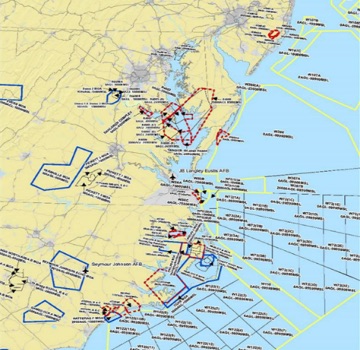Featured Projects
U.S. Air Force, Versar, Inc.
ADAIR Environmental Assessments

Military special use airspace
EAS is supporting the development of six simultaneous Environmental Assessments (EAs) for the Air Force Air Combat Command (ACC) and Air Force Civil Engineer Center (AFCEC). The EAs assess the potential environmental impacts of proposed dedicated contract ADAIR sorties to improve the quality of training and readiness of pilots at Joint Base Langley – Eustis, Virginia; Joint Base San Antonio – Lackland, Kelly Field Annex, Texas; Kingsley Field Air National Guard Base, Oregon; Eglin Air Force Base (AFB), Florida; Tyndall AFB, Florida; and Joint Base Pearl Harbor – Hickam, Hawaii.
The action includes elements affecting the base and military training airspace. The number and type of contract ADAIR aircraft, maintenance personnel, and pilots differ at each installation. Coordination among multiple government participants is critical to the success of the project and includes coordination with Headquarters Air Force (HAF), ACC, AFCEC, National Guard Bureau (NGB), U.S. Navy, US Army Corps of Engineers (USACE) Mobile District, as wells pilots and staff at each of the six installations.
EAS is providing critical advisory, facilitation, and scheduling support for this highly complex project. EAS plans and leads a critical bi-weekly call with over 45 ACC, AFCEC, NGB, USACE, installation, and contractor personnel to review progress and next steps, fill data gaps, address critical issues, identify action items, and review and update the project schedule. Our staff also provide senior advisory services related to project approach, brainstorming resolution to challenges, data validation, stakeholder involvement, quality assurance/quality control, data collection and other aspects of the overall Air Force Project Statement of Work.
U.S. Forest Service, Washington Resource Conservation and Development Council (WRC&D)
National Environmental Policy Act Planning for Trout Lake Insect and Disease Restoration Project – Colville National Forest

Trout Lake project map
EAS worked closely with Forest Service planners to evaluate restoration needs and approaches to correct the long-term impacts of fire suppression within ecosystems that require frequent low- to moderate-intensity fires. The Trout Lake Restoration Project would include up to 3,000 acres of commercial and non-commercial treatments in the upper Columbia River basin near Kettle Falls, Washington. Treatment would occur primarily through thinning, regeneration harvest, and fuels reduction (e.g. underburning, pile burning) to reduce the vulnerability of the planning area to insect and disease and to reduce the wildfire risk to local communities and surrounding federal lands.
The EAS team worked as an extension of the Forest Service interdisciplinary team and facilitated most aspects of the NEPA review for the project, including collaboration, public meetings, project scoping, resource surveys, developing a range of alternatives, preparing treatment prescriptions, evaluating potential impacts, preparing technical reports and biological evaluations, and maintaining a project record. The EAS team also completed a suite of permitting reviews and associated project modifications to ensure compliance with NEPA, the National Forest Management Act, Endangered Species Act, Clean Water Act, Clean Air Act, and National Historic and Preservation Act.
